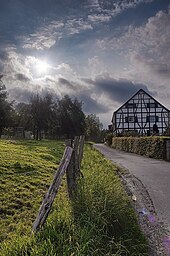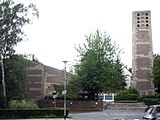Fish sheets
|
Fischlaken |
|

|
|
| Basic data | |
|---|---|
| surface | 9.17 km² |
| Residents | 4676 (March 31, 2020) |
| Coordinates | 51 ° 23 '20 " N , 7 ° 1' 36" E |
| height | 122 m |
| Incorporation | Apr 1, 1929 |
| Spatial assignment | |
| Post Code | 45239, 45257 |
| District number | 42 |
| district | District IX Werden / Kettwig / Bredeney |
| image | |
|
Haus Scheppen , former feudal farm on Lake Baldeney in Fischlaken |
|
| Source: City of Essen statistics | |
Fischlaken is a district in the south of the city of Essen . It is a predominantly rural district with forest areas, farms, but also denser residential areas.
history
A number of implements, most notably flints, have been found on agricultural land. Some of them come from the Bronze Age , others from the Mesolithic and the oldest relics from the epoch around 30,000 BC. BC, which is known as the Paleolithic . Even pits and post holes from ancient times suggest a very early settlement.
On the one hand, the name refers to a sheet, which means something like standing water (for example, lake , English for lake), and on the other hand to the abundance of fish.
The name Fischlaken first appeared in the 8th century. Fischlaken is therefore the oldest village on the Ruhr . When Theganbalds gave the Alfgatinghof to the founder of the Werden monastery, Liudger, in 796 , the village evidently came into being. A copy of the deed of donation from the 10th century is kept in the State Archives in Leiden . Until the secularization of 1803 due to the Reichsdeputationshauptschluss , Fischlaken belonged to the Reichsabtei Werden , which maintained agricultural areas and fish ponds there. The larger courtyards were enfeoffed by Werden Abbey. After that, Fischlaken belonged to the community of Siebenhonnschaften in the Werden-Land mayor of the Essen district south of the Ruhr . This was incorporated into the city of Essen in 1929 together with Fischlaken.
The inhabitants of the small village Fischlaken initially lived from agriculture and forestry, before coal mining began at the Richradt colliery in 1578 . The Pörtingsiepen colliery there was in operation from 1779 to 1973 and at times provided work for over 2000 people. There is little evidence of industrial use on a large scale in the late 19th and early 20th centuries.
The corridor Weinberg is partly also on Werden area. There were street names here early on, such as vine tendrils , Rebstock and Weinberg . An old vineyard near Kettwig is mentioned as early as 1877, which led historians to cast a bow after Fischlaken.
In 1782 the Werden abbot Bernhard II allowed the tenants of the Scheppen family and the farmers of Fischlaken to build a school. It was initially called Schule am Stüfken, later it was named after the abbot and was located on today's Fischlaker Straße. After the half-timbered house burned down in 1885, a stone house was built there for the Catholic Bernhardschule in the same year. In 1969 it became a special school with the name Ruhrtalschule. The evangelical Luisenschule was built on Bernhardstrasse in 1910, but closed in 1939 and destroyed in the Second World War in 1943. On September 14, 1955, the Peter Ullner School opened, today's non-denominational Fischlaker elementary school.
coat of arms
Blazon : "In blue between silver (white) raised and lowered bars, a horizontal silver (white) fish."
The coat of arms was designed by Kurt Schweder and never had an official character. At the end of the 1980s, the heraldist created coats of arms for all of Essen's districts. They have meanwhile been well received by the Essen population. The coat of arms is a so-called " talking coat of arms "; the earlier spellings "Fis (e) lacu" and "Wislaken" are names for stagnant water with a rich fish population. The shield image expresses this.
population
On March 31, 2020, 4,676 people lived in Fischlaken.
Structural data of the population in Fischlaken (as of March 31, 2020):
- Proportion of the population under 18-year-olds: 16.7% (Essen average: 16.2%)
- Proportion of the population of at least 65-year-olds: 26.2% (Essen average: 21.5%)
- Proportion of foreigners: 8.9% (Essen average: 16.9%)
Affiliations and Politics
The former Honnschaft Fischlaken together with Heidhausen , Hamm, Holsterhausen, Klein- Umstand , Hinsbeck and Rodberg formed the community of Siebenhonnschaften and thus belonged to the Werden-Land mayor in the Essen district . On April 1, 1929, Fischlaken was incorporated into the city of Essen.
From 1946 to 1975 the wholesale merchant Hans Toussaint (CDU) represented the municipal electoral district 40, which Bredeney forms together with Fischlaken and Schuir , in the city council of Essen. Toussaint served as Lord Mayor of Essen from 1949 to 1956. From 1975 to 1999 the lawyer and notary Wolfgang Reiniger (CDU) won this electoral district. Reiniger was elected Lord Mayor of Essen in 1999 and was re-elected in 2004. In the local elections in 2004 and 2009, the lawyer Matthias Hauer (CDU) in local electoral district 40 was elected to the city council of Essen; the highest CDU result in the city was achieved in each case. Ulrich Beul (CDU) has represented Fischlaken in the city council of Essen since the 2014 local elections.
character
One of the residential areas in a predominantly rural area is the factory estate on Lürsweg and Lürshöhe, which was built in the 1950s based on the model of a garden city with detached single and two-family houses.
Fischlaken is limited in the west by Werden , in the southwest by Heidhausen , in the southeast by Kupferdreh and in the north by Heisingen and Bredeney with the Ruhr as a border river.
In public transport , the buses on line 180 provide a connection from Fischlaken to the neighboring districts of Werden and Kupferdreh. With the federal road 224 Fischlaken is directly connected to an important traffic artery in Essen.
Attractions
In the area of the former Pörtingsiepen colliery , the sheave of the headframe was erected as a memorial. Furthermore, the former noble Lehnshof Haus Scheppen from the 13th century is located on Lake Baldeney . Here, directly on Lake Baldeney, there is a nationally known motorcycle meeting point. The White Fleet on Lake Baldeney offers excursions.
The Hespertalbahn , a museum railway that is operated with historic steam and diesel locomotives 25 days a year, is a reminder of the old days of rail transport .
Churches
The Ascension Church was built in 1952 from the barn of the former Wintgenhof as a Catholic emergency church . Its windows were created by the Werden glass painter de Graaf. The Wintgenhof house was converted into a rectory in 1956. A year later, the former Werden rectorate community became its own parish. The new church designed by Felix König from Heisingen was inaugurated after the laying of the foundation stone on August 9, 1963 on the fourth Sunday of Advent, December 20, 1964 between Wintgenstrasse and Lürsweg.
The Catholic Church to the Sorrowful Mother Maria belongs to the other churches and is no longer financially supported by the diocese of Essen . The Protestant Jona Church at Am Schwarzen was completed according to a design by architects Otto Vogel and E. Brennecke and inaugurated on February 14, 1965. The New Apostolic Congregation Fischlaken (later Werden) existed from 1908 to 2008, but only got its own church building, a towerless cube, on Wintgenstrasse in 1968.
Associations / Organizations
The Heidhauser Reiterverein Maashof is connected to the Maashof. As early as 1512 there was the Padberg treatment center here. The Fischlak funeral association was founded in 1877 on the initiative of Fischlak citizens. Previously it was customary to transport the dead to the cemetery chapel in a simple hay wagon, from now on there was a hearse for the deceased members. The association is operated as a death fund .
See also
Web links
literature
- Ludger Fischer : Fish sheets. Gem at the Baldeneysee . 2nd Edition. Beleke, Essen 2000 ( Essen historically . Volume 4).
Individual evidence
- ↑ See also Johann Rainer Busch: Kurt Schweders Wappen der Essener Stadtteile Essen 2009, p. 107
- ↑ Population figures of the districts
- ↑ Proportion of the population under 18 years of age
- ↑ Proportion of the population aged 65 and over
- ↑ Proportion of foreigners in the city districts
- ^ Westdeutsche Allgemeine Zeitung WAZ from May 25, 1963







